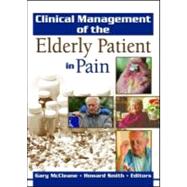- ISBN: 9780789026200 | 0789026201
- Cover: Nonspecific Binding
- Copyright: 5/11/2006
Up-to-date information on pain management--including options to consider when conventional treatment is ineffective Providing effective treatment for pain-especially to elderly clients-can be a vexing problem for even the most knowledgeable clinician. In Clinical Management of the Elderly Patient in Pain, some of the world's leading authorities describe the unique difficulties that arise when trying to provide pain relief to elderly patients. They examine conventional treatment with opioid and non-steroidal anti-inflammatory drugs along with a broad range of alternatives to consider when frontline drugs fail. Non-drug options for pain relief from the fields of physical medicine and psychology are also explored. Essential topics addressed in Clinical Management of the Elderly Patient in Pain include: pain as an aspect of advancing age how pharmacology differs in elderly patients available therapeutic options, including opioids, non-steroidal anti-inflammatory drugs, anti-epileptic drugs, tricyclic antidepressants, membrane stabilizers, and topical agents physical medicine approaches psychological approaches to pain in the elderly Most publications on this subject focus on the use of opioids, non-steroidal drugs, and other commonly prescribed analgesics. Clinical Management of the Elderly Patient in Pain takes a different approach. Editor Gary McCleane, MD, says, Our need, with elderly patients, is to provide treatment that is both effective and easily tolerated. This is not a book devoted to opioids and non-steroidals, although they are addressed. Nor is it about those analgesics used in younger patients being used in smaller doses with the elderly. Rather, it contains practical options for treating pain when other simple remedies fail to help. At times this will involve using conventional analgesics in scaled-down doses, but at others it will involve using substances not yet fully recognized as possessing analgesic properties because they fit the bill in terms of possible analgesic actions, side-effect profiles, and lack of drug/drug interactions--and because practical experience suggests they may be useful in the scenario described.” Clinical Management of the Elderly Patient in Pain is designed as a point of interface between the specialist pain practitioner and the clinician faced with all the problems of satisfactorily managing pain in elderly patients. It presents commonsense, practical, patient-oriented options that make it a useful resource for busy clinicians.







